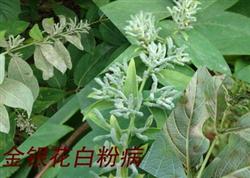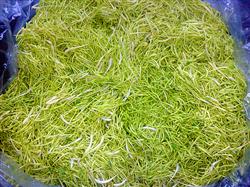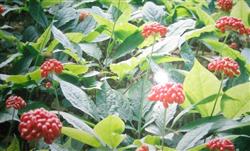What diseases and insect pests need to be controlled to grow honeysuckle?

What diseases and insect pests do you need to control when planting honeysuckle? Please introduce and guide the control methods of planting honeysuckle, the main control methods are powdery mildew and leaf spot, the main insect pests are aphids and so on. The control methods can be referred to as follows: (1) powdery mildew is the main disease of honeysuckle. It mainly harms the leaves and tender stems of Honeysuckle. The disease spot on the leaf is a small white spot at first, and then expands into a white powdery spot. In the later stage, the whole leaf is covered with a layer of powdery powder, and in severe cases, the leaf is yellow and deformed or even deciduous. Warm and humid or shaded between plants is easy to develop. If too much nitrogen fertilizer is applied, the disease will be serious alternately between dry and wet. At the time of onset, 75% chlorothalonil was sprayed 800 times, once every 7 days, 3 times continuously. Or spray 75% DuPont Yibao 800g 1000 times liquid (for prevention) or 400g / liter EC 6000m8000 times solution for the prevention and control of powdery mildew. At the initial stage of the disease, 50% methyl topiramate wettable powder or triadimefon 1000-fold solution can be sprayed every 5-7 days for 2-3 times. This kind of pesticide should be banned during flowering! (2) at the onset of leaf spot disease, the leaves showed small yellow spots, gradually developed into small brown round spots, and finally dried up and perforated. Prevention and control methods: the diseased leaves should be removed immediately to prevent spread, and 65% Dai Senmeng zinc wettable powder 400 × 500 times or 75% Ruidui 800 × 1000 times solution should be sprayed continuously for 2 times for 3 times. It can also be sprayed with 3% Jinggangmycin 50ppm solution or 1RV 1.5-200 Bordeaux solution at the initial stage of the disease, once every 7-10 days, 2-3 times in a row. Strengthen cultivation and management, increase the application of organic fertilizer to enhance plant disease resistance; (3) leopard bark moth a, symptoms: larvae eat from branches or new shoots, bite a circle between xylem and phloem, 3-5 days later, the killed new shoots wither and the branches are broken by the wind. When the larvae grow to 3-5 mm, insect feces are excreted at the wormhole, which is cylindrical, yellowish and unbreakable. Generally, there are several defecation holes on one side of the injured branch. This larva has the habit of transplant damage. Dead branches appeared in the damaged plants from September to October. B, control methods: clean up the damaged branches and dry in time; spray 1500 times of 40% dimethoate EC and 0.3-0.5% kerosene during the peak incubation period of larvae in mid and late July. (4) Honeysuckle inchworm a, symptom: it mainly harms the leaves, and all the leaves of the plant are eaten up when it occurs. B, control methods: clean the countryside, reduce the source of overwintering insects, and spray with 1000-1500 times of 40% dimethoate EC during infancy. (5) aphids a, symptoms: damage from Qingming Festival to Lesser Fullness of Grain, more serious after the Beginning of Summer, and faster spread of wet weather, which can cause leaves and buds to curl and branches to stop growing. B. Control methods: stone-sulfur mixture was generally sprayed once before germination, and pesticides such as dimethoate emulsion were sprayed once during Qingming, Grain Rain and the Beginning of Summer respectively. Click to get more honeysuckle planting technology click to get more medicinal material planting technology
- Prev

How to pick and dry honeysuckle?
How to pick and dry honeysuckle? Please give an introduction to the picking and drying of honeysuckle can refer to the following methods: 1. Picking: The picking period of honeysuckle is generally in late May, the second crop is in mid-July, the third crop is around mid-August, and the fourth crop is in mid-October. The first crop flowers bloom more concentrated, about 5-7 days, 2 days.
- Next

How to apply fertilizer to plant ginseng (American ginseng)?
How to apply fertilizer to plant ginseng (American ginseng)? Ginseng and American ginseng are perennial root plants and have strict requirements for fertilizer. After expert research, it is found that it is a potassium-loving plant, and its absorption of potassium is far greater than that of nitrogen and phosphorus, that is to say, potassium is an important factor to determine whether ginseng is high-yield or not. And as it grows.
Related
- Fuxing push coffee new agricultural production and marketing class: lack of small-scale processing plants
- Jujube rice field leisure farm deep ploughing Yilan for five years to create a space for organic food and play
- Nongyu Farm-A trial of organic papaya for brave women with advanced technology
- Four points for attention in the prevention and control of diseases and insect pests of edible fungi
- How to add nutrient solution to Edible Fungi
- Is there any good way to control edible fungus mites?
- Open Inoculation Technology of Edible Fungi
- Is there any clever way to use fertilizer for edible fungus in winter?
- What agents are used to kill the pathogens of edible fungi in the mushroom shed?
- Rapid drying of Edible Fungi

